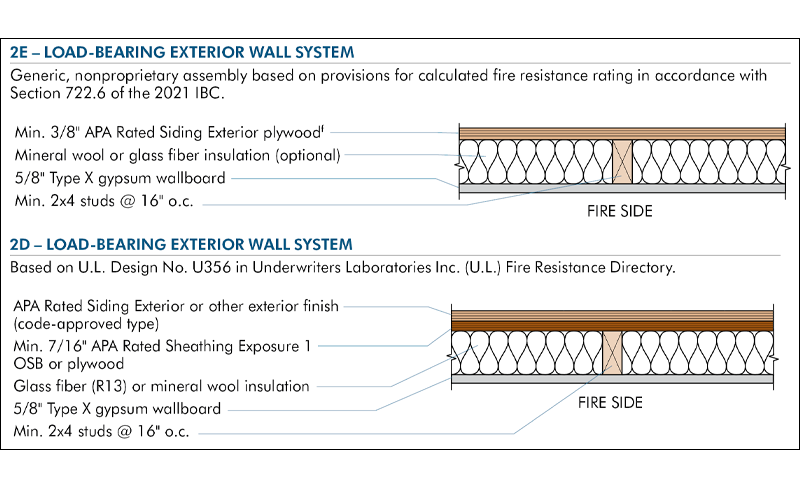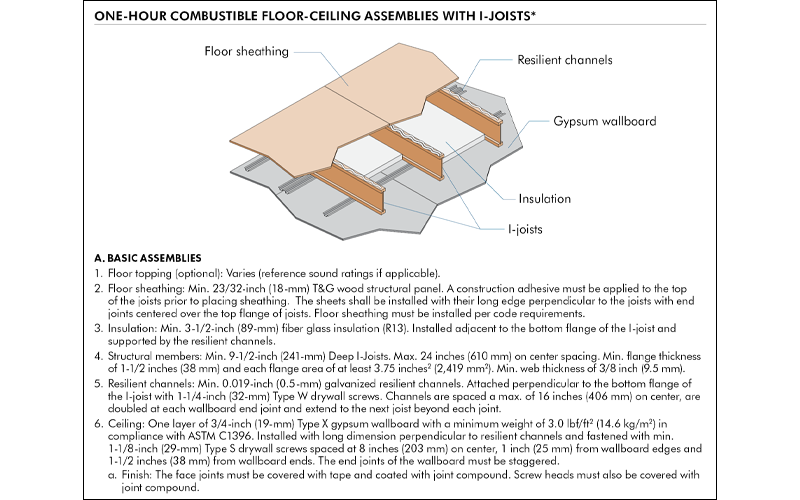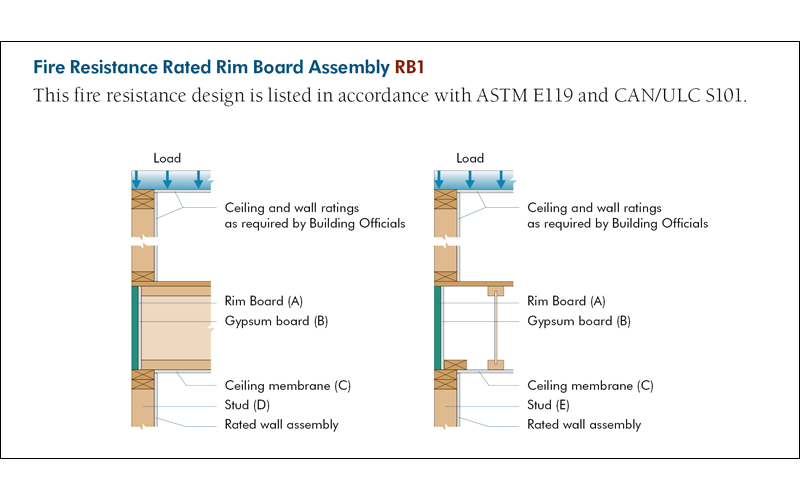While no building is truly fireproof, construction materials and systems can make a building fire safe. Fire-resistive construction gives time to discover a fire, suppress it before it spreads and evacuate the building, if necessary. Designing buildings that provide good fire protection, cost-effectively, can be challenging.
The problem arises from a lack of standardized code provisions and insurance rating practices, as well as the rapid advancements in construction technology. Many of these advances have changed and improved wood construction's acceptance by building codes and insurance rating agencies. Here’s a glimpse into some of the most cost-effective, fire-rated construction systems you can design or build using engineered wood products.
Fireproof vs. Fire Safe
Because most inhabited buildings have flammable contents and furnishings, there’s no such thing as a truly “fireproof” building. If these contents catch fire, they can quickly generate enough smoke and heat to cause extensive damage.
While “fireproof” is probably not attainable, fire-resistant construction is well within reach. Extensive testing of building components and systems has resulted in approved fire-rated assemblies that retain the structural capacities to contain a fire long enough for inhabitants to escape. With proper construction in conformance with code regulations, a “fire safe” building can be designed.
Different Methods of Fire Protection
In many cases, ordinary wood-frame construction with wood structural panel sheathing provides ample fire safety and is acceptable. When unusual circumstances require additional protection, the designer’s options include protected construction, mass timber construction or heavy timber construction.
- Protected construction is any wood assembly with fire-resistive materials (such as gypsum wallboard, plaster or acoustical tile) added to give primary protection to the wood members.
- Mass timber construction provides fire protection by using mass timber, which is defined in the International Building Code (IBC) as “structural elements of Type IV construction, primarily of solid, built-up, panelized or engineered wood products that meet minimum cross-section dimensions of Type IV construction.”
- Heavy timber construction implies the fire protection provided by timbers with large dimensions in accordance with the IBC. In such construction, though the outside of the timber may char during fire exposure, the surface char acts as insulation. The strength of the timber remains and the member continues supporting the load, greatly reducing the chance of building collapse.
- Fire-retardant-treated (FRT) wood is pressure-impregnated with chemicals in water solution or other means during manufacture to inhibit combustion. Pressure-impregnated treatment is a secondary process, separate from the primary lumber or EWP manufacturing process. FRT wood does not increase fire resistance beyond the untreated members but can significantly reduce the flame spread under fire exposure, as compared to untreated members.
- Fire-retardant paints can be used on plywood for nonstructural interior finish applications, such as wall and ceiling paneling, to reduce flame spread rates, depending on paint selected.
- Sprinklers: With sprinkler protection, code requirements for flame spread and fire-resistance ratings may be relaxed.
Building for Fire Protection
Following are some examples of how to protect different areas of a building. There are many assembly options available. Additional options can be found in APA’s Fire-Rated Systems design and construction guide. How you select an assembly will likely be based on costs and needs.
Wall Systems
The following examples show an Underwriters Laboratory Inc. (U.L.) Fire Resistance Directory design and an example from section 722.6 of the 2021 IBC.

Floor and Roof Systems
Many floor-ceiling (or roof-ceiling) systems are listed in the U.L. Fire Resistant Directory and are accepted as rated construction by building codes. Here is one example of a fire-rated assembly using prefabricated wood I-joists.

Rim Board Assemblies
APA’s Data File: Rim Board in Fire-Rated Assemblies offers detailed information on six fire-rated rim board assemblies. The example wall assembly below shows an I-joist floor system installed perpendicular to rim board or installed parallel to the rim board. The 5/8-inch Type X or regular 5/8-inch gypsum wallboard shown on the ceiling is to protect the rim board only; it does not necessarily cause the floor assembly to be rated.

Additional Considerations
The IBC places limitations on the height and area of a building according to its compliance with certain established criteria, which are based on the health and safety of occupants. Because light-frame construction is usually the best choice from the standpoint of cost and ease of construction, yet is accorded the lowest basic allowable areas, it is to the designer’s advantage to find ways to secure area increases to take advantage of the economy and versatility of wood construction.
The following suggestions can help:
- One-hour fire resistance: The IBC allows the area of wood-frame buildings to be increased when one-hour fire resistance is provided for all load-bearing structural elements in the building, including beams and columns, floors, walls and roofs.
- Automatic sprinklers: The IBC has provisions that allow building areas to be increased when an automatic sprinkler system is installed throughout the building.
- Building separation: Basic area increases are allowed if there are large open areas on two or more sides of a building. A 175% increase is allowed if all sides face toward public streets.
- Unlimited areas: Provisions are made for the construction of unlimited area buildings for industrial, storage or business uses. Generally, there must be large areas of open space surrounding the building, and the building must be completely sprinklered.
- Fire walls: The equivalent effect of area increases can be achieved by introducing properly constructed fire walls. The effect during a fire is similar to the effect on two contiguous buildings when separated by a fire-rated wall or fire-rated partition with all openings protected.
For more information, including additional code-approved, fire-rated assembly designs, more visual examples, and details for glued laminated timber assemblies, download APA’s free Fire-Rated Systems design and construction guide. For a more interactive deep-dive into fire-rated assemblies in wood-frame construction, watch APA’s free on-demand webinar, Fire-Rated Systems in Wood Construction. AIA and ICC CEUs are available to participants.






